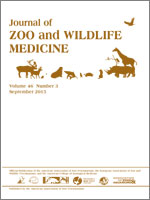Tramadol is a synthetic, centrally acting, opiate-like analgesic that is structurally related to codeine and morphine. The objective of this study was to determine the pharmacokinetics of tramadol hydrochloride and its major active metabolite O-desmethyltramadol (M1) in the California sea lion (Zalophus californianus). A single dose of tramadol was administered orally in fish at 2 mg/kg to a total of 15 wild California sea lions admitted for rehabilitation. Twenty-four total blood samples were collected post drug administration at 10, 20, 30, and 45 min and at 1, 3, 5, 6, 8, 12, and 24 hr. Blood plasma was separated and stored at −80°C until analysis with high-performance liquid chromatography was performed to determine levels of tramadol and M1, the major active metabolite. The results indicate that the plasma levels of parent tramadol are low or negligible during the first 30–45 min and then reach the predicted mean maximum plasma concentration of 358 ng/ml at 1.52 hr. The M1 metabolite was not detectable in 21 of 24 plasma samples, below the level of quantification of 5 ng/ml in one sample, and detectable at 11 and 17 ng/ml in two of the samples. This study suggests that a 2 mg/kg dose would need to be administered every 6–8 hr to maintain concentrations of tramadol above the minimum human analgesic level for mild to moderate pain. Based on dosing simulations, a dose of 4 mg/kg q8 hr or q12 hr, on average, may represent an adequate compromise, but further studies are needed using a larger sample size. Pharmacodynamic studies are warranted to determine if tramadol provides analgesic effects in this species. The potential for tramadol toxicosis at any dose also has not been determined in this species.
How to translate text using browser tools
1 September 2015
PHARMACOKINETICS OF TRAMADOL HYDROCHLORIDE AND ITS METABOLITE O-DESMETHYLTRAMADOL FOLLOWING A SINGLE, ORALLY ADMINISTERED DOSE IN CALIFORNIA SEA LIONS (ZALOPHUS CALIFORNIANUS)
Jennifer L. Boonstra,
Lorraine Barbosa,
William G. Van Bonn,
Shawn P. Johnson,
Frances M. D. Gulland,
Sherry K. Cox,
Tomas Martin-Jimenez
ACCESS THE FULL ARTICLE
California sea lion
M1
marine mammal
tramadol
Zalophus californianus





